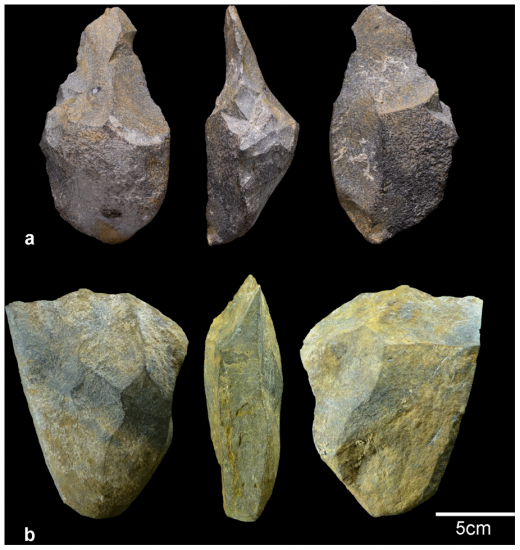Source - http://www.pasthorizonspr.com/index.php/archives/08/2014/million-year-hominid-dispersal-event-in-iberia?
It was a world full of diverse large mammals that lived on what is now the Iberian peninsula up to 1 million years ago. This detailed reconstruction of the environment has been carried out by researchers from the Higher Council for Scientific Research (CSIC) and the Catalan Institute of Human Palaeoecology and Social Evolution at the site of the ravine Boella, Canonja (Tarragona).

Million year old Rhinoceros jaw – one of the 500 faunal remains found on the site. Image: © CSIC
Archaeological remains dating to between 1 million to 780,000 years were also found on an excavation that has provided evidence of the first known human occupation in the Iberian Peninsula.
The study published in the journal PLoS ONE examines one of the first indicators and traces of prehistoric human dispersal technology – Acheulean – which in the Early Pleistocene was widespread in Africa but not in Eurasia.
In fact, the Acheulean technology lithics became widespread in European archaeological sites after the final settlement of the continent, which is believed to be during the second half of the Middle Pleistocene (between 500,000 to 125,000 years ago).
The existence of the Oldowan Acheulean technology at that time in the Iberian Peninsula shows a new hominid dispersal event, possibly from Africa. “This suggests the presence of Acheulean in Europe up to a million years ago, so that new immigrants coexisted in the Peninsula with more archaic populations,” explains Antonio Rosas.

Barranc de la Boella large cutting tools (LCT).a) split cobble of schist showing trihedral pick configuration from level 2 at Pit 1 Locality (P1L) site; b) schist cleaver from level 2 at EF site. Image: © CSIC
“The gully of La Boella is a new set of sites that provide valuable information about the biological and cultural evolution of human populations in the Lower and Middle Pleistocene, a unique period of human evolution,” said a CSIC researcher.

Herd of megafauna mastadons by Charles R. Knight. Image Wikimedia
A rich megafauna
Among the fossil species recovered, investigators identified; mammoths, rhinos, bears, deer, and hippos. The presence of hippo, and the bones from a beaver, suggests that hominids exploited natural resources near watercourses and environments subject to flooding. Another of the conclusions reached by the study related to carnivore activity nearby. They recorded teeth marks on the remains of large animals, and also found fossilised faeces, showing animals such as hyenas were scavenging for food.
The work has involved professionals from different disciplines and institutions to establish a chronological, archaeological and palaeobiological context of the site.
The archaeological record of Barranc de la Boella completes the geographical distribution of large cutting tool (LCT ) assemblages across southern Eurasia during the Early-Middle Pleistocene Transition (EMPT), circa 942 to 641 kyr. Until now, chronology of the earliest European LCT assemblages was based on the abundant Palaeolithic record found in terrace river sequences which have been dated to the end of the EMPT and later.
The findings at Barranc de la Boella suggest that early LCT lithic assemblages appeared in the SW of Europe during earlier hominin dispersal episodes several tens of thousands of years before the definitive colonization of temperate Eurasia took place.
Source: CSIS
Josep Vallverdú, Palmira Saladié, Antonio Rosas et al. Age and date for early arrival of the Acheulian in Europe (the ravine Boella, the Canoja, Spain). PLOS ONE. DOI: 10.1371/journal.pone.0103634